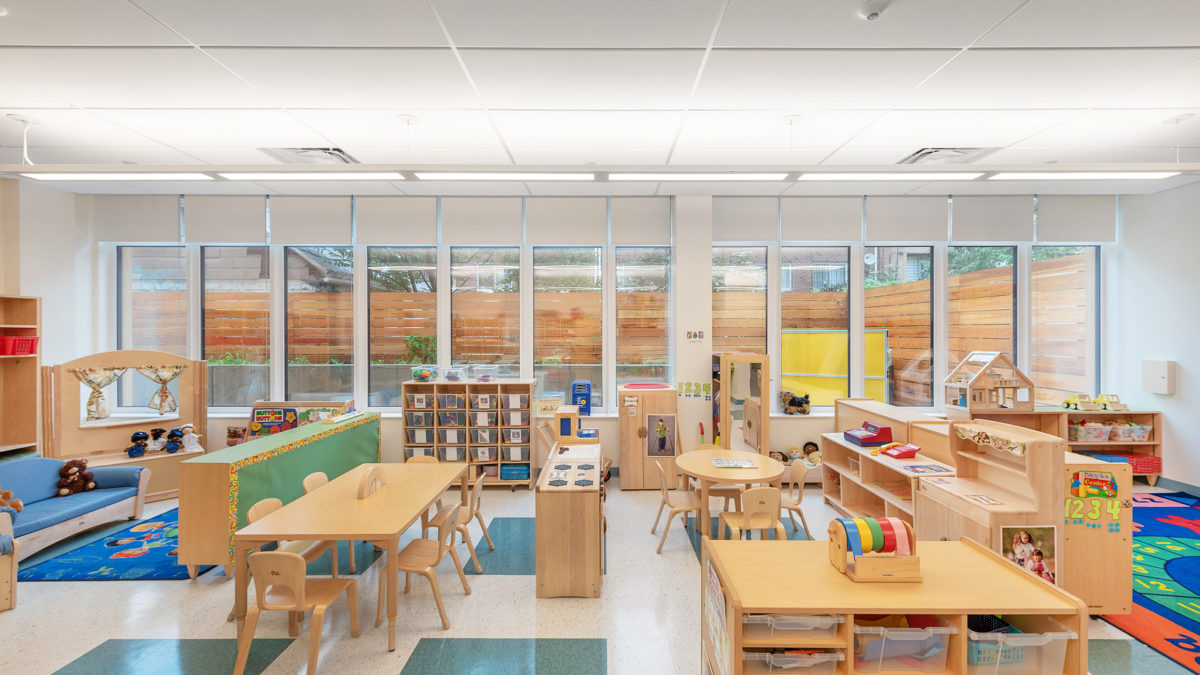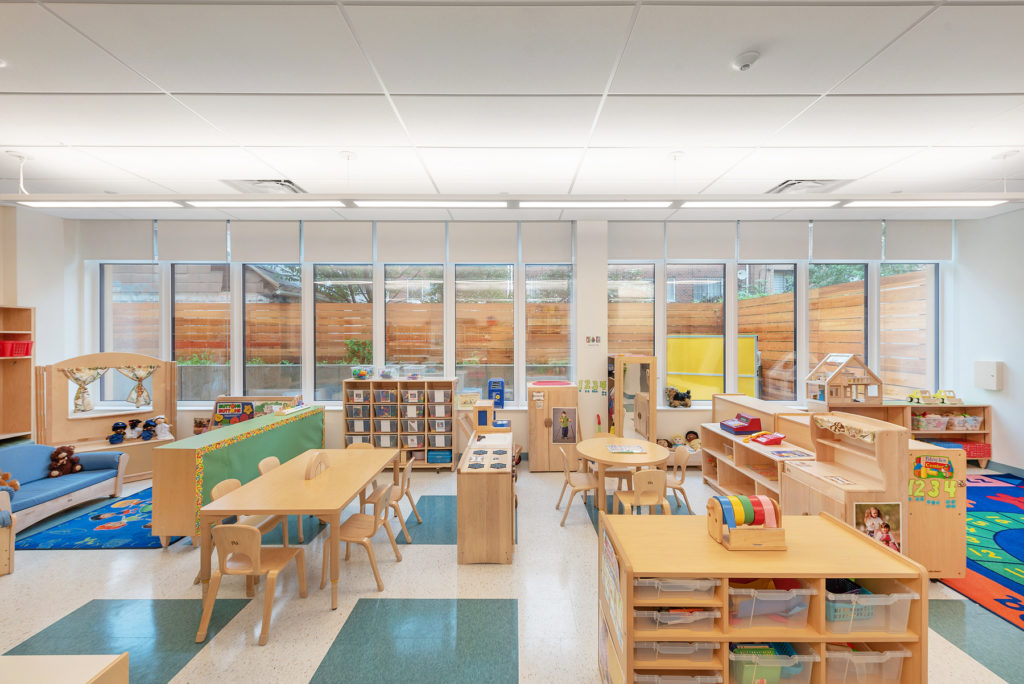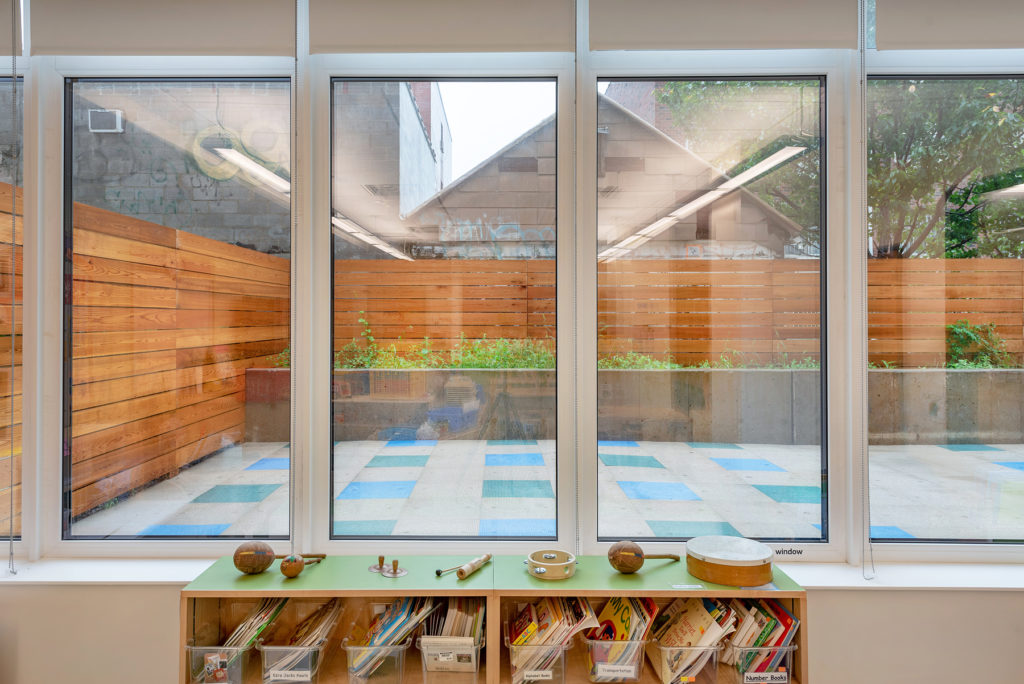

New York City School Construction Authority and CTA Architects, P.C. have completed New York City’s and United States’ first-ever pre-kindergarten built within a passive house building and designed to meet passive house standards. Located in the Corona section of Queens, UPK Q368 – also known as the Mosaic Pre-K Center – is situated near LeFrak City.
According to Craig Tooman, AIA, LEED-AP, the CTA principal in charge of the Pre-K project, “The 4,700-square foot, three-classroom facility on the ground floor of the Senior Residence uses only one-eighth the amount of energy a typical pre-k of a similar size would use. It houses a general office, a staff room, a parents/community room, an infirmary, a custodial space, a lobby, and a warming pantry that is equipped with a small kitchen area with a milk chest, a warming cabinet, and a connected food-storage room.” There is also a 1,200-square foot play yard that is only accessible by going through the pre-K.
UPK Q368 marks CTA’s ninth universal pre-k design for the SCA thus far. The SCA has been building universal pre-kindergartens throughout the five boroughs. CTA’s universal pre-K work has varied from one-classroom schools to those with up to 25 classrooms.

New York City’s Pre-k for All program promises to offer every 4-year-old New Yorker a high-quality, free, full-day pre-kindergarten seat. This program provides one full year of education to children prior to beginning kindergarten, in order to give young students “an important foundation for success in school, home, and life.” Studies have shown that early childhood education lays a foundation that improves performance throughout a child’s educational experience. Universal pre-K teaches youngsters to play together, share, take turns, and channel their thoughts into words as they develop physical coordination, learn letters, numbers, shapes, and colors, and learn to ask questions.
The passive house building that houses UPK Q368 is the HANAC Corona Senior Residence, developed by HANAC, Inc. – the Hellenic American Neighborhood Action Committee. The HANAC Corona Senior Residence is expected to achieve Passive House Certification this summer, which will confirm it complies with environmentally forward Passive House Design standards. Passive House Design requirements include 75% energy savings in comparison to typical properties as well as significant environmental benefits for the physical health, comfort, and overall well-being of those who reside in, work in, learn in, and/or visit this facility.
HANAC, created in 1972, provides an array of services, including the development of affordable housing and the provision social services for New York City’s most vulnerable populations. HANAC has developed and manages a portfolio of over 600 affordable housing units with onsite social services for their tenants. The HANAC Corona Senior Residence is an eight-story, 68-unit, 58,000-square foot affordable housing apartment building for very low-income seniors. It is the very first affordable senior housing development in the country that meets the design standards of the Passive House Institute. Of the 68 units, there is one two-bedroom unit, 61 one-bedroom units, and six studio apartments.
A “passive house” building is a structure built on the principles of the Passive House Institute (PHI), an independent research organization founded in Germany that is dedicated to the researching and development of construction concepts, building components, planning tools, and quality assurance for extraordinarily energy-efficient buildings that are comfortable, affordable, and ecological – all at the same time. Passive house buildings are constructed in such a way that their heating- and cooling-related energy use saves up to 75% over typical new builds (and saves up to 90% over traditional building stock). They do this, in part, by making the most of energy sources inside the building – residents’ body heat or solar heat entering the building, for example, while a high-efficiency heat-recovery unit reuses the heat contained in the exhaust air. Similarly, extremely well-constructed and -insulated windows, exterior walls, roof, and floor slab keep heat in during winters and out during summers. The ventilation systems used in passive house buildings are designed to supply continuous fresh air without creating uncomfortable drafts.
According to Tooman, conforming to the passive house building’s reduced energy-consumption requirements was the team’s biggest challenge. “These types of ultra-energy efficient designs are becoming much more popular, both city-wide and worldwide. Passive house requirements go well beyond those of LEED-certified buildings – the energy consumption is much, much lower,” he noted. The CTA team worked within a “super-insulated” building envelope to reduce energy consumption within the space.
Further, the pre-K space is connected to the base building’s energy-recovery system. CTA worked with its passive house consultant, YR&G New York (now WSP USA Inc.)– and the Association for Energy Affordability (AEA), the Passive House consultant for the base building – to incorporate the same systems and energy-efficient approach that the base building had. A variable-refrigerant flow (VRF) condenser was installed on the roof of the HANAC building for the pre-K space, for example. “The mechanical systems are designed to keep the energy inside the envelope of the building, and to preheat or cool the fresh air supply. This not only lowers the energy load, but it maintains a much clean healthy environment,” Tooman added. The pre-K has a separate entrance from the senior center and uses the same triple-glazed storefront system.
Materials and Finishes
CTA wanted each classroom to have its own distinct color “language.” Therefore, the team made one classroom yellow, one green, and one blue. Three of the gypsum walls in all three of the classrooms are painted a very pale yellow color, with the fourth accent wall painted in a vibrant hue to match that classroom’s theme. Similarly, all of the classrooms’ vinyl floor tiles are in a checkerboard pattern, with the predominant field a speckled white with the accent tiles mirroring that classroom’s chosen color theme. Meanwhile, the designers brought the effervescent yellow, green, and blue of the classrooms into the common areas, particularly in the hallway and the front lobby-type area.
The lobby area is actually a particularly unusual feature in a pre-kindergarten. Such a space is not specified by the SCA. Rather, it was HANAC’s requirement. The organization wanted to make sure that when one is walking down 101st Street and is looking into the pre-K space, one immediately sees children playing or interacting with one another in some way. In other words, the glass façade of the first floor should make it clear that in one part of the building there are children, and in the other part of the building there are seniors.
